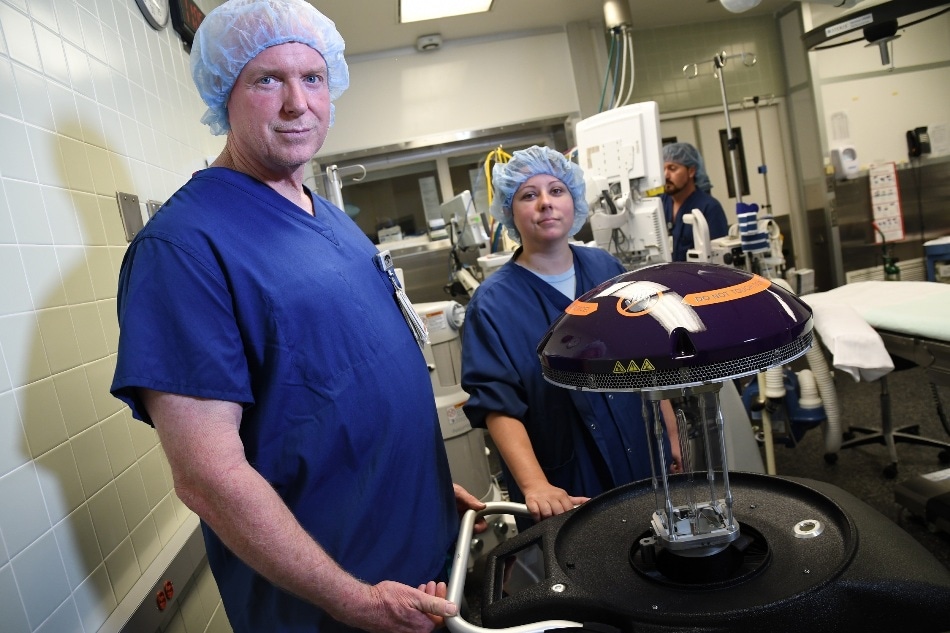Sep 13 2016
In many underdeveloped countries, where water treatment is unavailable and water-borne diseases are rampant, people rely on a simple method to kill germs in their drinking water: they pour it in a clear container and set it in the sun. “Sunshine is the best disinfectant” goes the old saying; although it might not be the best — because it can take several hours of direct sun to kill most bacteria — it is certainly effective.
 Sharp Coronado Hospital has deployed a Xenex Germ-Zapping Robot to destroy germs and bacteria lurking in the hospital that can pose a risk to patient safety. Pictured with the robot are Stephen Decker, general manager of environmental services, and Lindsay Schimpf, RN, CCRN, infection preventionist Sharp Coronado Hospital. (Photo: Business Wire)
Sharp Coronado Hospital has deployed a Xenex Germ-Zapping Robot to destroy germs and bacteria lurking in the hospital that can pose a risk to patient safety. Pictured with the robot are Stephen Decker, general manager of environmental services, and Lindsay Schimpf, RN, CCRN, infection preventionist Sharp Coronado Hospital. (Photo: Business Wire)
But what if you could increase the intensity of the ultraviolet rays of the sun by 20 times? By 100 times? By 2,000 times? You’d have yourself a germ-killing machine.
Sharp Coronado Hospital has just this. Created by San Antonio-based Xenex Disinfection Services, the Xenex Germ-Zapping Robot™ is the latest tool in the hospital’s arsenal to reduce hospital-acquired infections. The portable machine blasts a pulsed beam of broad-spectrum UV light that destroys the cellular walls and genetic material of 99.9 percent of all microorganisms — including germs that can be missed or escape the effects of traditional cleaning methods.
“The Xenex unit will not replace our current methods of cleaning,” explains Chris Walker, chief nursing officer at Sharp Coronado. “It will supplement what we do with bleach and thorough scrubbing. But it will give us an incredible, additional level of protection against germs that might be left on surfaces by earlier patients.”
Antibiotic-resistant pathogens such as MRSA (methicillin-resistant Staphylococcus aureus) and C.diff (Clostridium difficile) are of particular concern in hospital settings; but even flu, enterovirus and the common cold are worries. The Xenex device quickly kills them all – and because it uses pulsed xenon (not mercury bulbs) to create UV light, it is environmentally friendly.
The light from the robot’s xenon bulb is so intense that no person can be exposed to its beam. The unit is wheeled into a room and turned on remotely. After 5 to 10 minutes, it turns itself off and is moved to another position so it can attack surfaces from a different angle. For safety, a motion-detector turns the light off immediately should someone enter the room.
At Sharp Coronado, the germ-killing robot will be used initially in the hospital’s surgical suites; but it can be moved to patient rooms, waiting rooms, even restrooms — wherever germs might be hiding.
Walker points out another important value of the Xenex unit. “As we worry about infectious surges or new outbreaks of such things as flu, Ebola or Zika, it will be all the more important to have a means by which we can swiftly and effectively clean a room and make ready for the next patient,” he says.
He notes that Sharp HealthCare has set a goal of zero hospital-acquired infections; and the germ-killing robot will be an important weapon in that fight. Numerous healthcare organizations using Xenex robots have reported significant reductions in their C.diff, MRSA, VRE and Surgical Site Infection (SSI) rates and published their HAI reduction results in peer-reviewed journals.